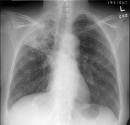Faculty peer reviewed
In a city of over 8 million people, New York City has an annual tuberculosis case rate of 11.4 per 100,000 people, which is more than twice the national average.[1] Seventy-one percent of these cases occur in people who were born outside the United States.1 As a student, I had a patient (Y) who was being evaluated for active tuberculosis because he is a household contact of a person (X) known to have active multi-drug resistant tuberculosis. I wondered what his chances were of infection. If he has the infection and is asymptomatic, is he contagious to others?
Tuberculosis is spread by the cough of an infected person when droplet nuclei travel to the lungs.[2] A single bacillus may cause infection.2 Bacteriological evidence of disease by smear analysis or culture is the gold standard for diagnosis. Patients with tuberculosis are classified as smear-positive, culture-positive, or culture-negative. Smear-positive is the most infectious, but half of tuberculosis cases are smear-negative.[3] The difference in transmission is found in the number of organisms in the sputum. In smear-positive persons, there are 106 to 109 acid-fast bacilli per milliliter of sputum, while there are fewer in the sputum of a smear-negative person.3 Because tuberculosis is spread by airborne droplets, many factors affect transmission, including the nature of the exposure, the ventilation of the environment, and the duration and intensity of exposure.3
Historical epidemiological studies have compared the tuberculin positivity rates of known contacts of an index case to the positivity rates of the local community. In general, the rate of tuberculin positivity among household contacts of smear-positive patients ranges from 30 to 50% above the community rates.3 Young children appear to be the most susceptible.2 The tuberculin positivity rate among household contacts of smear-negative patients is only about 5% above the community rate; however, a recent study revealed that 17% of new cases of tuberculin positivity were acquired from smear-negative patients.3,[4]
Studies by Loudon and Roberts showed increased rates of transmission among contacts exposed to coughing and singing versus talking.[5] They found that coughing and singing produced a greater quantity of droplets present after 30 minutes. In a boarding school outbreak, a higher rate of infection was seen in kids who were in a choir group with the index case as compared to kids who were exposed in other settings.[6] Ventilation also appears to play a factor in transmission of disease. A study aboard the naval ship USS Byrd showed higher conversion rates in sleeping compartments that shared recirculation of contaminated air in a closed ventilatory circuit. Other nearby compartments that did not share ventilation with the index case had lower rates of transmission.[7]
Another study involving children who were exposed to tuberculosis from their school bus driver showed a difference in conversion rates based on duration of exposure.[8] Of the children who rode the bus less than 10 minutes per day, 22% were found to be tuberculin positive in comparison to 57% of children riding greater than 40 minutes per day. Similar studies of hospital cases have shown an increased rate of tuberculin positivity in patients who have longer exposure to a roommate with tuberculosis.3 The rate of tuberculin positivity increased with the number of days spent sharing a hospital room. Additionally, the effects of the intensity of exposure have been shown in community studies of casual versus close contacts of a smear-positive patient.3 Casual contacts were noted to have the lowest rates of tuberculin positivity, while spouses were shown to have greater rates than other family members.
Although many variables play a role in the transmission of tuberculosis, the strongest predictor of contagiousness appears to be the smear status of the host. The index case, X, is smear- negative after several weeks of treatment. The household contact, patient Y, has an unknown tuberculin and smear status. Patient Y has cohabitated with patient X for over one year. Studies of close contacts of smear-positive patients indicate that up to 50% become tuberculin positive. This can vary greatly with patient’s degree of closeness with patient X, the amount of ventilation, coughing, and type of bacteria. However, patient Y had a negative chest x-ray and is symptom-free. Although bacteriological evidence is the gold standard for diagnosing tuberculosis, a South African study showed that chest x-ray is a very sensitive alternative to smear and culture for screening for tuberculosis.[9] Based on the patient’s lack of symptoms and negative chest x-ray, patient Y is unlikely to have smear- or culture-positive tuberculosis necessitating infectious precautions. If he has been infected with tuberculosis, he is at low risk for transmitting tuberculosis in the community.
Molly Cason is a 4th year medical student at NYU Medical Center.
Faculty peer reviewed by Dr. Joel Ernst
[1] TB Annual Summary: 2007. New York: New York City Department of Health and Mental Hygiene, 2008.
[2] Musher DM. Medical Progress: How contagious are common respiratory tract infections? New Engl J Med. 2003; 348(13):1256-1266.
[3] Sepkowitz KA. How Contagious is tuberculosis? Clin Infect Dis. 1996;23(5):954-962.
[4] Behr MA, Warren SA, Salamon H, et al. Transmission of Mycobacterium tuberculosis from patients smear-negative for acid-fast bacilli. Lancet. 1999;353(9151):444-449.
[5] Loudon RG, Roberts RM. Singing and the dissemination of tuberculosis. Am Rev Respir Dis. 1968;98(2):297-300.
[6] Bates JH, Potts WE, Lewis M. Epidemiology of primary tuberculosis in an industrial school. N Engl J Med. 1965;272:714-717.
[7] Houk VN. Spread of tuberculosis via recirculated air in a naval vessel: the Byrd study. Ann NY Acad Sci. 1980;353:10-24.
[8] Rogers EF. Epidemiology of an outbreak of tuberculosis among school children. Public Health Rep. 1962;77:401-409.
[9] den Boon S, White NW, van Lill SW, et al. An evaluation of symptoms and chest radiographic screening in tuberculosis prevalence surveys. Int J Tuberc Lung Dis. 2006;10(8):876-882.


One comment on “How Easily is Tuberculosis Spread?”
Comments are closed.